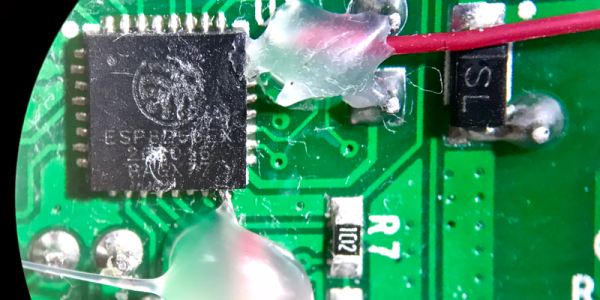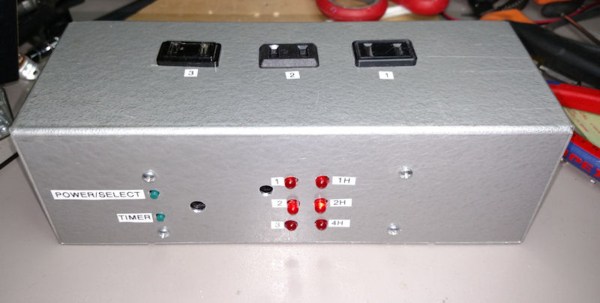Economies of scale and mass production bring us tons of stuff for not much money. And sometimes, that stuff is hackable. Case in point: the $5 Sonoff WiFi Smart Switch has an ESP8266 inside but the firmware isn’t very flexible. The device is equipped with the bare minimum 1 MB of SPI flash memory. Even worse, it doesn’t have the I2C ports extra pins exposed so that you can’t just connect up your own sensors and make them much more than just a switch. But that’s why we have soldering irons, right?
home hacks1867 Articles
Oscillating Fan Controller Used As Relay
The most brilliant hacks we see aren’t always the thousand-dollar, multi-year projects spanning every facet of engineering. Rather, the most ingenious projects are ones that take an everyday thing and use it in a simple but revolutionary way. By that measure, it’ll be hard to top [Robert]’s latest hack which uses the controller board from an everyday oscillating fan to build a three-way remote-controlled relay board.
Most oscillating fans have a speed selector switch. What that does might be somewhat different between different types of fan, but in general it will select either a smaller portion of the fan’s motor to energize or switch in a resistor which will have the same speed-lowering effect. [Robert]’s fan had little more than a triple-throw switch on the control board, so when he decided the fan wasn’t worth keeping anymore, he was able to re-purpose the control board into a general-use relay. As a bonus, the fan could be controlled by infrared, so he can also remote control whatever he decides to plug into his new piece of equipment.
While this simple hack might not change the world, it may give anyone with an old fan some ideas for other uses for its parts. If you want to do a little more work and get the fan itself running again, though, it is possible to rebuild the whole thing from the ground up as well.
Zelda And The Ocarina Of Things
Voice recognition is this year’s model for home automation, but aside from feeling like you’re onboard the Aries 1b arguing with HAL 9000, it just doesn’t do it for our geeky selves. So what’s even geekier? How about carrying around an ocarina in your pocket so that you can get a Raspberry Pi to unlock the door for you? (YouTube video, embedded below.) Yeah, that’ll do.
[Sufficiently Advanced]’s video gets us 90% of the way toward replicating this build. There’s a tube with a microphone and a Raspberry Pi inside. There are a bunch of ESP8266-powered gadgets scattered around the house that take care of such things as turning on and off the heater, watering plants, and even pressing a (spare) car remote with a servo.
We’d love to know what pitch- or song-recognition software the Raspberry Pi is running. We’ve wanted to implement a whistling-based home automation interface since seeing the whistled. We can hold a tune just fine, but we don’t always start out on the same exact pitch, which is a degree of freedom that [Sufficiently Advanced]’s system doesn’t have to worry about, assuming it only responds to one ocarina.
If you’re questioning the security of locking and unlocking your actual apartment by playing “Zelda’s Lullaby” from outside your window, you either overestimate the common thief or you just don’t get the joke. The use case of calling (and hopefully finding) a cell phone is reason enough for us to carry a bulky ocarina around everywhere we go!
Cheap Modules Upgrade Home Security System
[gw0udm] had an ancient monitored alarm system fitted to their home, and decided it was time to upgrade to something a little more modern. They chose a system from Texecom, but when it came time to hook it up to their computer, they were alarmed at the costs – £40 for what amounted to a USB-to-Serial cable! There were other overpriced modules too. But [gw0udm] wanted to upgrade, so it was time to hack the system.
The first step was grabbing a £4 USB-to-Serial board and wiring it up – a simple job for the skilled hacker. As we always say – everything speaks serial. [gw0udm] then set their sights higher – they wanted the Ethernet interface but weren’t about to cough up the coin. After some research, it was determined that a Raspberry Pi could be used with a utility called ser2net with the existing serial interface to do pretty much the same job. It was a simple matter of figuring out the parity and messaging format to get things up and running.
From there, the project moves on to tackling the creation of a GSM module for monitoring in the absence of a local network, and on flashing the firmware of the system itself. It’s great to see a project continually grow and expand the functionality of a product over time.
We see a lot of security systems here at Hackaday – high prices and proprietary hardware tend to inspire the hacker spirit. Check out this reverse engineering of an obsolete 1980s system, resplendent with Eurostile font.
Modern Wooden Houses With No Glue Or Nails
Depending where you are in the world, the techniques used to build houses can sometimes seem to be stuck in another century. Bricks and mortar, for instance, we build with them because we are used to them and have a large workforce of people trained to work with them and not much else. But in the 21st century with more advanced building technologies sitting relatively unused and looming housing crises at every turn, does it make sense to still build houses the slow and expensive way our great-grandparents did? Probably not.
Wooden houses are a promising solution to some of the problems outlined in the previous paragraph, and indeed in large parts of the world wood is the housing material of choice. It’s eco-friendly, not too expensive, and can be applied easily to multiple different types of structure. If you think of a wooden house, does the image of a log cabin come to mind, or perhaps a weatherboard house? Both construction methods that would be familiar again to your great-grandparents, so perhaps you might not call it an advanced building technology.
It’s interesting then to see an innovation from France, a system of interlocking wood sections that can be built into walls that look very similar to brick (Here’s the French language original). These are short sections of board cleverly designed with dovetailing to engage with vertical sections that interlock between different courses and leave a gap between wooden inner and outer faces of the wall that can be filled with insulation material. The effect is to create a wooden building system that can produce a vast range of structures that can be assembled in a very short time indeed. This isn’t prefabricated housing, but it delivers the speed you’d expect from it.
They have a video shoving construction of a typical house in rather idyllic French countryside, which we’ve put below the break. It has French language annotations, however for non Français speakers the context is pretty obvious.
Continue reading “Modern Wooden Houses With No Glue Or Nails”
Zero-Intrusion Wireless Light Switch
What do you do if your light switch is too far from your desk, and you’re in a rental property so you can’t put in extra wiring to install an electronic control for it? Get up and turn it on or off by hand? Of course not!
If you are [Guyfromhe], you solve this problem with a servo attached to a screw-on light switch faceplate, and you control it with a pair of Arduino/nRF24L01 combos. It’s a pretty simple arrangement, the wireless link simply takes the place of a serial cable that instructs the Arduino on the light switch to operate the servo that in turn moves the switch. The whole thing is triggered through his home automation system, which in turn responds to an Amazon Dash button on his desk. Yes, it’s complex. But turning on the light has been automated without intrusion into his landlord’s domain, and that’s all that matters.
On a more serious note, he’s put some Arduino code up on his write-up, as well as a YouTube video we’ve put below the break.
3D Print Your Next Dwelling In A Day
What’s the shortest amount of time in which a 400 square foot home can be built? A few weeks? Try a fully printed structure in 24 hours for a little over $10,000.
This radial residence was materialized out of concrete in Stupino, Russia by [Apis Cor], and six collaborating companies, as a prototype. As opposed to traditional — such as it is for tech largely in its infancy — assembly of pre-printed or fabricated pieces, the building was printed as a whole, with the printer removed by crane before finishing the rest of the construction. It features a bathroom, hallway, living room, and a compact kitchen — everything a bachelor or bachelorette needs.

















